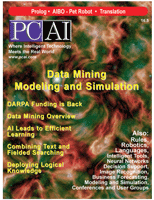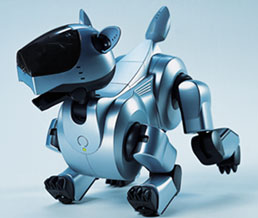Volume 16,
Issue 5
 |
 |
|
|
Volume 16,
Issue 5
|
|
|
||
| 16.5 | ||
| Theme: Data Mining, Modeling and Simulation |
|
|
|
Computer Understanding |
|
Known worldwide as the
day of the Superbowl, January 26, 2003 also starts another competition
with far longer-term ramifications for humanity. It marks the beginning
of the next Man vs. Machine Chess competition (see PC AI 16.4 and 15.1
for comments on previous matches). With Deep Blue capable of calculating
two hundred million moves per second, earlier competitions depended on
raw computer power - Deep Blue received its name based on how extensively
it could analyze each move, and literally process millions of possible
combinations. This year's contestant, Deep Junior, only calculates three
million positions per second; yet its programmers feel confident that
the key to this competition is its understanding of chess. They believe
Deep Junior is the beginning of a new era of programs that understand
the abstract concepts in chess - as compared to the shear power approach
of older chess programs. There are a number of web sites covering the
Chess competition for those that are interested, some with live updates
(see www.chessbase.com,
www.playchess.com and www.x3dworld.com).
What is of particular interest to PC AI readers is the abstract understanding that the programmers are using to enable Deep Junior to compete with less computing power. Remember Deep Junior is 67 times slower than is its predecessor Deep Blue. We have already seen how a higher-level understanding of a problem offers performance savings in applications of AI such as expert systems (business rules) and neural networks. Systems based on these technologies are developed considerably faster, with less manpower, and are often much more efficient than their C, C++, or even Java counterparts. The savings comes from the knowledge representation, the processing of the knowledge (such as an inference engine versus embedded code, training on data versus manually program coding, just to name a few). This efficiency, in part, is why the concepts of data mining, and for that matter, modeling and simulation have become so popular - they handle complex problems, find complex patterns within enormous volumes of data, without requiring tremendous quantities of manual processing (see What is Data Mining: Finding the Pattern). The government has also renewed its interest in computer understanding and cognitive computing. It is gearing up to find methods of applying AI technology by requesting proposals for DARPA funding (see DARPA Renews AI Funding in Key Technologies). The government sees a number of potential benefits to this technology. One in particular, Enduring Personalized Cognitive Assistant (EPCA) attempts to change the paradigm of how industry designs, builds and uses computers. The result could be intelligent assistants that do simple tasks; freeing humans to spend more time doing activities that are more complex. DARPA funding in the late 70's and 80's encouraged, and in many cases brought about a number of successful technologies that are already part of the computer mainstream such as object oriented development, business rules, robotics, data mining, intelligent agents, pattern matching and character recognition, just to name a few. At one time Apple was also actively pursuing AI technologies and they created one of the most interesting videos ever generated on the subject - The Knowledge Navigator. I ran across that video online a while back and you can check it out in the Apple's Knowledge Navigator side bar of the DARPA article. What is interesting about this video is that most of the technology exists today to make this a reality - it is the understanding to chain the technologies together that still needs to be developed. One final note - Sony continues to lead the world in commercializing personal robots for the consumer market. See Your Next Pet - Make it AI Enabled for more information on the latest from Sony. Based on the flurry of AI activity already in just the first month of the year, 2003 looks to be a very good year for AI. |
|
|
||||
|
|
|
|
|
|